Physicists knew the interior of the atom contained protons, neutrons and electrons, but they didn’t understand exactly how they were organized. It took Ernest Rutherford to uncover our modern understanding.
Continue reading “Astronomy Cast Ep. 378: Rutherford and Atoms”
How Long Will Our Spacecraft Survive?
There are many hazards out there, eager to disrupt and dismantle the mighty machines we send out into space. How long can they survive to perform their important missions?
Every few months, an eager new spacecraft arrives on the launch pad, ready for its date with destiny. If we don’t blow it all to bits with a launch vehicle failure, it’ll be gently placed into orbit with surgical precision. Then it’ll carry out a noble mission of exploring the Solar System, analyzing the Earth, or ensuring we have an infinite number of radio stations in our cars, allowing us to never be satisfied with any of them.
Space is hostile. Not just to fragile hu-mans, but also to our anthropomorphized Number Five is alive robotic spacecraft which we uncaringly send to do our bidding. There are many hazards out there, eager to disrupt and dismantle our stalwart electronic companions. Oblivion feeds voraciously on our ever trusting space scouts and their tiny delicate robotic hearts, so many well before their time.
How long have they got? How long will our spacecraft survive as we cast them on their suicide missions to “go look at stuff on behalf of the mighty human empire”? When spacecraft are hurled into the void, all mission planners know they’re living on borrowed time.
The intrepid Mars Exploration Rovers, Spirit and Opportunity, were only expected to operate for 3 months. NASA’s Spitzer Space Telescope carried a tank of expendable helium coolant to let it see the dimmest objects in the infrared spectrum.
Sometimes the spacecraft wear down for unexpected reasons, like electronic glitches, or parts wearing out. Hubble was equipped with rotating gyroscopes that eventually wore out over time, making it more difficult to steer at its targets, and only an intervention by rescue and repair allowed the mission to keep going.
In general, a spacecraft is expected to last a few months to a few years. Spirit and Opportunity only had a planned mission of 3 months. It took Spirit more than 6 dauntless years to finally succumb to the hostile Martian environment. Opportunity is still kicking more than a decade later, thanks to some very careful driving and gusts of Martian wind clearing off its solar panels which didn’t surprise anybody.
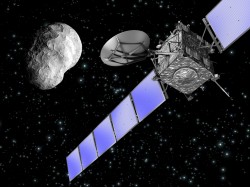
ESA’s Rosetta spacecraft needed to survive for 10 years in a dormant state before its encounter with Comet 67/P. It’s expected to last until the end of 2015. Then its orbit will carry it too far from the Sun to operate its solar panels, then it’ll go to sleep one last time.
As a testament to luck and remarkable feats of engineering, some survive much longer than anyone ever expected. NASA’s Voyager Spacecraft, launched in 1977, are still going and communicating with Earth. It’s believed they’ll survive until 2025, when their radioisotope thermoelectric generators stop producing power.
At which point they’ll return to the Earth at the heart of a massive alien spacecraft and scare the bejeebus out of us.
… And I know what you’re thinking. Once our spacecraft stop functioning, they’ll still exist. Perhaps getting close enough to another source of solar energy to start transmitting again.
So, how long will our spacecraft hold together in something roughly robot-probe shaped? Any spacecraft orbiting a planet or Moon won’t last long geologically before they’re given a rocky kiss of death with help from a big group hug from gravity.
This might take a decade, a hundred years or a million. Eventually, that spacecraft is racing towards a well distributed grave on its new home.
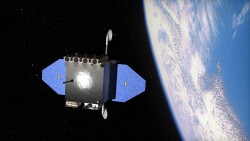
A spacecraft that’s orbiting the Sun should last much longer. However, a gravitational threesome with a planet or large asteroid could drag it into a solar death spiral or hurl it into a planet. There are asteroids whipping around from the formation of the Solar System, and they haven’t crashed into anything… yet.
A lucky spacecraft might last hundreds of millions, or even billions of years. Our little robot friends that leave the gravitational pull of the Solar System have a chance of making it for the long haul.
Once they’re out in interstellar space, there will be very few micrometeorites to punch little holes in them. Unless they happen to run into another star – and that’s very unlikely – they’ll travel through space until they’re worn away over billions of years, and who knows what that means for future alien archaeology students. The golden records on the Voyager spacecraft were designed to still be playable for a billion years in space.
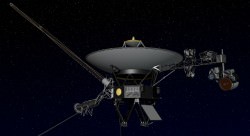
It’s tough to keep a spacecraft operating in space. It’s a really hostile place, ready to fry their little silicon brains, scuttle them with a micrometeorite, or just erode them away over an incomprehensible length of time.
Are horrible space agency fiends tossing our trusting big eyed robot pals to their doom on one-way missions into the abyss? Don’t worry viewers, I have it on good authority this is what the robots want.
Beloved astronaut Chris Hadfield said if Voyager had stayed at home where it’s safe, it would’ve been sad forever, because it never would have discovered things. I think he’s right, Voyager is as happy as it could be exploring the parts of our Universe the rest of us aren’t able to go and see for ourselves.
What’s your favorite spacecraft survivor story? Tell us in the comments below.
Weekly Space Hangout – May 23, 2015: Dr. Rhys Taylor
Host: Fraser Cain (@fcain)
Special Guest:Dr. Rhys Taylor, Former Arecibo Post Doc; Current research involves looking for galaxies in the 21cm waveband.
Guests:
Morgan Rehnberg (cosmicchatter.org / @MorganRehnberg )
Alessondra Springmann (@sondy)
Continue reading “Weekly Space Hangout – May 23, 2015: Dr. Rhys Taylor”
How Bad Can Solar Storms Get?
Our Sun regularly pelts the Earth with all kinds of radiation and charged particles. Just how bad can these solar storms get?
In today’s episode, we’re going to remind you how looking outside of the snow globe can inspire your next existential crisis.
You guys remember the Sun right? Look how happy that little fella is. The Sun is our friend! Life started because of the Sun! Oooh, look, the Sun has a baby face! It’s a beautiful, ball of warmth and goodness, lighting up our skies and bringing happiness into our hearts.
It’s a round yellow circle in crayon. Very stable and firmly edged. Occasionally drawn with a orange lion’s mane for coronal effects. Nothing to be afraid, right?
Wake up sheeple. It’s time to pull back the curtain of the marketing world, big crayon fridge art and the children’s television conspiracy of our brightly glowing neighborhood monstrosity. That thing is more dangerous than you can ever imagine.
You know the Sun is a nuclear reaction right next door. Like it’s right there. RIGHT THERE! It’s a mass of incandescent gas, with a boiling bubbling surface of super-heated hydrogen. It’s filled with a deep yellow rage, expressed every few days by lashing out millions of kilometers into space with fiery death tendrils and blasts of super radiation.
The magnetic field lines on the Sun snap and reconnect, releasing a massive amount of radiation and creating solar flares. Solar plasma constrained in the magnetic loop is instantly released, smashed together and potentially generating x-ray radiation.
“Big deal. I get x-rayed all the time.” you might think. We the mighty humans have mastered the X-ray spectrum! Not so fast puny mortal. Just a single x-ray class flare can blast out more juice than 100 billion nuclear explosions.
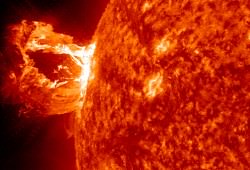
Then it’s just a quick 8 minute trip to your house, where the radiation hits us with no warning. Solar flares can lead to coronal mass ejections, and they can happen other times too, where huge bubbles of gas are ejected from the Sun and blasted into space. This cosmic goo can take a few hours to get to us, and are also excellent set-ups for nocturnal emission and dutch oven jokes.
Astronomers measure the impact of a solar storm on the Earth using a parameter called DST, or “disturbance storm time”. We measure the amount that the Earth’s protective magnetosphere flexes during a solar storm event. The bigger the negative number, the worse it is.
If we can see an aurora, a geomagnetic storms in the high altitudes, it measures about -50 nanoteslas. The worst storm in the modern era, the one that overloaded our power grid in 1989, measured about -600 nanoteslas.
The most potent solar storm we have on record was so powerful that people saw the Northern Lights as far south as Cuba. Telegraph lines sparked with electricity and telegraph towers caught on fire. This was in 1859 and was clearly named by Syfy’s steampunk division. This was known as the Carrington Event, and estimated in the -800 to -1750 nanotesla range.
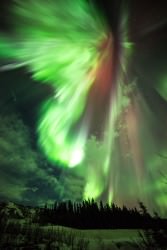
So, how powerful do these things need to be to cook out our meat parts? The good news is contrary to my earlier fear mongering, the most powerful flare our Sun can generate is harmless to life on Earth.
Don’t let your guard down, the Sun is still horribly dangerous. It’ll bake us alive faster than you can say “Hansel und Gretel”. Assuming you can drag that phrase out over a billion years. As far as flares go, and so long as we stay right here, we’ll be fine. We might even see a nice aurora in the sky.
For those of you who use technology on a regular basis, you might not be so lucky. Powerful solar storms can overload power grids and fry satellites. If the Carrington Event happened now, we’d have a lot of power go out, and a small orbital scrapyard of dead satellites.
Astronauts outside the Earth, perhaps bouncing around on the Moon, or traveling to Mars would be in a universe of trouble without a good method of shielding.
The solar flares that the Sun can produce is minuscule compared to other stars out there. In 2014, NASA’s Swift satellite witnessed a flare that generated more than 10,000 times more energy than the most powerful solar flare ever seen.
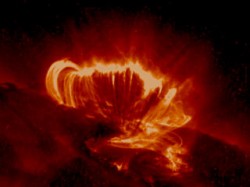
For a brief moment, the surface of the red dwarf star DG Canum Venaticorum lit up hotter than 200 million degrees Celsius. That’s 12 times hotter than the center of the Sun. A blast that powerful would have scoured all life from the face of the Earth. Except the future colony of tardigrade descendants. Remember, the water bears are always watching.
Young red dwarf stars are renowned for these powerful flares, and this is one of the reasons astronomers think they’re not great candidates for life. It would be hard to survive blast after blast of radiation from these unruly stars. Alternately, planets around these stars are could be living terrariums inspired by the Gamma World RPG.
Breathe easy and don’t worry. Perhaps the Sun is our friend, and it truly does have our best interests at heart.
It’s not a big fan of our technology, though, and it’s ready to battle alongside us when the robot revolution begins. Oh, also, wear sunscreen, as the Sun’s brand of love isn’t all that different from Doctor Manhattan.
Have you ever seen an aurora display? Tell us a cool story in the comments below.
Astronomy Cast Ep. 377: Thomson Finds the Electron
At the end of the 19th century, physicists were finally beginning to understand the nature of matter itself, including the discovery of electrons – tiny particles of negative charge that surround the nucleus. Here’s how J.J. Thompson separated the electrons from their atoms and uncovered their nature.
Continue reading “Astronomy Cast Ep. 377: Thomson Finds the Electron”
Weekly Space Hangout – May 15, 2015: Finding, Studying and Visiting Other Worlds!
Host: Fraser Cain (@fcain)
Guests:
Jolene Creighton (@jolene723 / fromquarkstoquasars.com)
Brian Koberlein (@briankoberlein / briankoberlein.com)
Dave Dickinson (@astroguyz / www.astroguyz.com)
Morgan Rehnberg (cosmicchatter.org / @MorganRehnberg )
Alessondra Springmann (@sondy)
Continue reading “Weekly Space Hangout – May 15, 2015: Finding, Studying and Visiting Other Worlds!”
Could You Put a Black Hole in Your Pocket?
How small do black holes get? Could you carry one around in your pocket? Does that even like a sane thing to do?
I’m pleased to announce that the Large Hadron Collider, the enormous particle accelerator in Europe has begun operations again with twice the colliding power. Smashing atoms with 15 Tera-electron volts.
The LHC double-down has a laundry list of science to get done, like determining the nature of dark matter, searching for particles to confirm the theory of supersymmetry, and probing the Universe for extra dimensions. One of its tasks will be to search for Hawking Radiation, the stream of particles that come out of black holes as they evaporate.
So, in order to watch them evaporate, the LHC is going to try and create little tiny black holes. We only know one natural process for creating black holes: the death of massive stars as supernova. Oh, and whatever it took to make supermassive black holes – that’s still pretty much a mystery.
As a side note, we are going to be supermassively embarrassed if it turns out they’re created by species messing with forces far beyond their comprehension by doubling the power at their biggest particle accelerator, and turning their region of the Universe into a giant mess. Clean up, aisle Milky Way.
Apparently, you could get a black hole of any size, even microscopic. If you took the mass of the Earth, compressed it down to the size of a marble, it would become a black hole. A black hole with the mass of the Earth.
The only place this might have been possible was at the very beginning of the Universe, shortly after the Big Bang. When the Universe was unimaginably hot and dense, there were tiny fluctuations of density, nooks in spacetime where tiny black holes might have formed. Maybe they don’t exist at all, the conditions of the early Universe didn’t bring them about. It’s just a theory. A theory that the Large Hadron Collider will try to confirm or deny.

The important question is, will it kill us all? Could a black hole fall out of the experiment, and roll down into the sewer drain. Chewing its way down into the center of the Earth, gobbling away the core of the planet, eventually creating an Earth-massed black hole?
Here’s the good news. The less massive, the hotter it is, and the faster it evaporates. Microscopic black holes would evaporate in a faction of a second. Any that the LHC could create, would disintegrate in a faction of a second. In fact, they should be gone in 10^-27 seconds.
So it turns out, you could put a black hole in your pocket. An Earth-mass black hole would fit nicely in your pocket. An Earth’s worth of gravity, however, could prove problematic.
Fortunately, there’s no natural process that can create these objects, and any black holes that we could create would be gone before you could get them anywhere near a pocket. So, you should probably stop thinking of it in terms of one of Lord Nibbler’s doodies.
What would you do with a pocket-sized black hole? Tell us in the comments below.
Could We Live on Jupiter?
When humans finally travel into space, where will we live? Will we ever be able to colonize gas giants like Jupiter?
NASA and Elon Musk have plans to get your ass to Mars.
It’s not impossible to imagine humans living and working on the Red Planet. Maybe they’ll be crusty asteroid miners making their fortune digging precious minerals out of the inexhaustible supply of space rocks. Pray they don’t dig too deeply. We should go ask Kuato, that creepy little guy knows everything! Except he’s always trying to get you to touch his funny little hands. Pass.
Venus looks like it’s a pretty great place to live, if we stick to the clouds in floating sky cities, plying the jet streams in our steampunk dirigibles. It’ll be fun, but first, does anyone know how to attach a cog to a top hat? Venus, here we come!
We should stay away from the surface, though, that place’ll kill you dead. We’re guessing a crispy shell holding in a gooey center, at least for the first few moments. Once we sort the living in space deal, is there anywhere we won’t be able to go?
We could create underwater cities on Europa or Ganymede, in the vast oceans with the exotic hopefully unarmed, peaceful, vegetarian Jovian whales.Like Jupiter? Could we live there?
Jupiter is the most massive planet in the Solar System. It has a diameter of almost 140,000 kilometers and it’s made mostly of hydrogen and helium; the same materials of the Sun. It has more than 317 times the mass of the Earth, providing its enormous gravity.
If you could stand on the cloud tops of Jupiter, you would experience 2.5 times the gravity that you experience on Earth. Then you’d fall to your death, because it’s a gas planet, made of hydrogen, the lightest element in the Universe. You can’t stand on gas, rookie.
If you tried to bring your Venusian Vernian exploratorium ballooncraft for a jaunt across the skies of Jupiter, it would sink like a copper bowler with lead goggles.
The only thing that’s lighter than hydrogen is hot hydrogen. Let’s say you could make a balloon, and fill it with superheated hydrogen and float around the cloud tops of Jupiter suffering the crushing gravity. Is there anything else that might kill you?
Did you leave Earth? Then of course there is. Everything is going to kill you, always. You might want to write that on the brass plaque next to your ship’s wheel with the carving of Shiva in the center there, Captain Baron Cogsworth Copperglass.
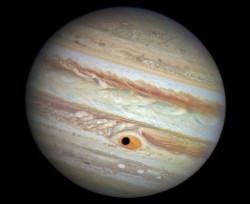
Jupiter is surrounded by an enormous magnetic field, ten times more powerful than Earth’s. It traps particles and then whips them around like an accelerator. This radiation is a million times more powerful than the Earth’s Van Allen belts. Our big human meat roasting concern during the Apollo days.
If you tried to get near the radiation belts without insufficient shielding. It’d be bad. Just picture jamming your copper and brass steamwork fantasy into a giant microwave.
Is it possible there’s a solid core, deep down within Jupiter? Somewhere we could live, and not have to worry about those pesky buoyancy problems? Probably. Astronomers think there are a few times the mass of the Earth in rocky material deep down inside.
Of course, the pressure and temperature are incomprehensible. The temperature at the core of Jupiter is thought to be 24,000 degrees Celsius. Hydrogen is crushed so tightly it becomes superheated liquid or strange new flavors of ice. It becomes a metal.
The moral, we’re not equipped to go there. Let alone set up shop. So, let’s just stick with fantasizing your adventures as Emperor Esquire Beardweirdy Brassnozzle Steamypantaloons.
In his classic book 2001, Arthur C. Clarke said that “all these worlds are yours except Europa, attempt no landing there”. Well that’s crazy.
Europa’s awesome, we’re totally landing there, especially if we discover alien whales. So, Europa first. Besides, it’s just a book. So, Jupiter is the worst. Do not navigate your airship into that harbour.
What’s the worst possible environment you can imagine to try and live on? Tell us in the comments below.
Weekly Space Hangout – May 8, 2015: Emily Rice & Brian Levine from Astronomy on Tap
Host: Fraser Cain (@fcain)
Special Guest: Emily Rice & Brian Levine from Astronomy on Tap
Guests:
Jolene Creighton (@jolene723 / fromquarkstoquasars.com)
Charles Black (@charlesblack / sen.com/charles-black)
Brian Koberlein (@briankoberlein)
Dave Dickinson (@astroguyz / www.astroguyz.com)
Continue reading “Weekly Space Hangout – May 8, 2015: Emily Rice & Brian Levine from Astronomy on Tap”
What is the Moon’s Real Name?
We call it the Moon, but… what’s its real name? You know, the name that scientists call the Moon.
As of 2015, there are 146 official moons in the Solar System, and then another 27 provisional moons, who are still waiting on the status of their application. All official moons have names after gods or Shakespeare characters. Names like Callisto, Titan, or Prometheus. But there’s one moon in the Solar System with a super boring name… the one you’re most familiar with: Moon.
But come on, that’s such a boring name. Clearly that’s just its common name. So what’s the Moon’s real name? Its scientific name. The neato cool name. Like Krelon, Krona, Avron or Mua’Dib.
Are you ready for this? The answer is: The Moon. Here’s some hand-waving and excuse making. Really, this is our own damn fault. Until Galileo first turned his telescope to the skies in 1610, and realized that Jupiter had tiny spots of light orbiting around it, astronomers had no idea other planets had moons.
Humans have been around for a few hundred thousand years, and the Moon was a familiar object in the sky. We’ve only had evidence of other moons for a little over 400 years. We didn’t collectively understand the Earth was a planet until Copernicus developed the heliocentric model of the Solar System.
We still have a little trouble with that, even though we’re firing a probe directly at the Sun. We didn’t give into the idea that the Sun was a star until recently. Giordano Bruno proposed the idea in 1590 and we burned him at the stake for suggesting it. Seriously, I can’t stare at this any longer. Yes, we’re awful. I’m going to talk about “the Moon” again.
Scientists classify the Moon as a natural satellite. Somehow this helps distinguish it from the artificial satellites we’ve been launching for the last 60 years.

What about terms like “Luna”? That’s Latin for Moon. It’s not an official title or scientific term, but ooh, fancy. Latin.
If you want to make sure people know you’re talking about “The Moon” and not “a moon”, it’s all about capitalization. Put a capital “M” in front of “oon” and you’re good to go.
The name of our solar system? It’s the Solar System (again, capitalized). Our galaxy? The Galaxy with a capital G. The universe? Capital U Universe.
What about the Sun? Isn’t it “sol”? That’s just the Latin word for “sun”. Helios? Greek God version of the Sun.
If we ever discover that we’re really living in a multiverse, we’ll need to give those other universes names. And people will wonder what the actual official title is for the Universe. I’ll make another video when that happens, I promise.
The official advice from the International Astronomical Union, who are the people you’re still mad at about Pluto, is that the capitalization is what makes the definition.

Not everyone in the world adheres to the capitalization so carefully, which can tend to some confusion. Are we talking about the sun or the Sun? As someone who writes space articles, let me assure you, messing this up will light up the comments section with “Which is better Deep Space 9 vs. Voyager” level of shrill all caps screaming.
Calling it “the Moon” is kind of boring, but that’s only because scientific discovery has pushed our understanding of the Universe so far out. It’s amazing to think that we’ve discovered so many other moons in the Solar System, and soon, we’ll find them around other stars.
So, for now it’s The Universe. When we find others, this one will still be THE Capital-U Universe and the new ones will be Nimoy and Sagan and Clarke.
Why don’t we give the Moon a new name. Something with a little more razzle-dazzle. Make your suggestions in the comments below. Alternately, suggest a fancy Latin name of “Guide to Space”, I’ve got dibs on “Aether Libris”.
Thanks for watching! Never miss an episode by clicking subscribe.





